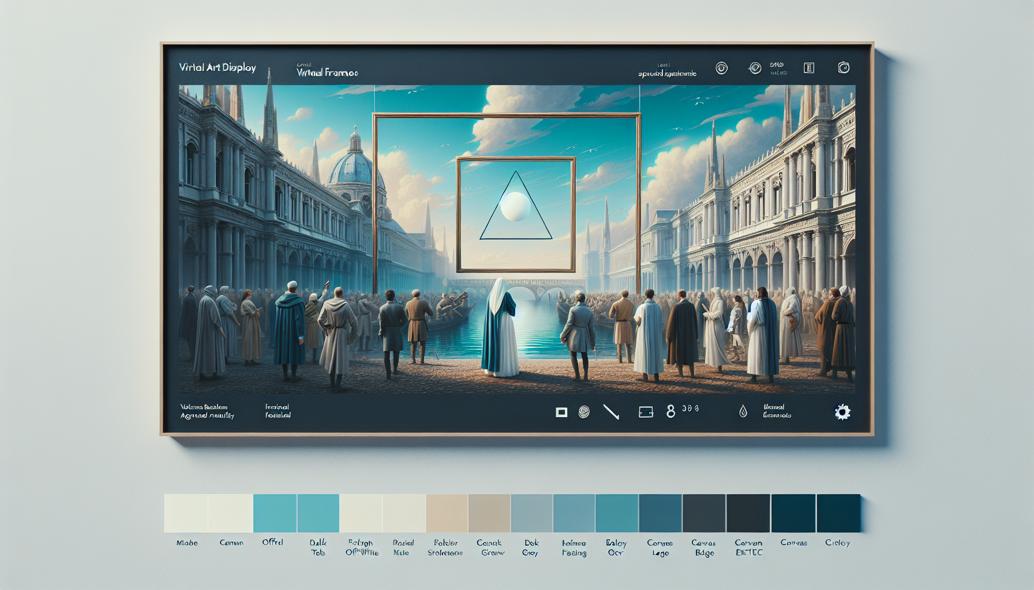The Future of Art Display - Virtual Frames and Augmented Reality
In a rapidly advancing tech landscape, virtual frames and augmented reality promise to transform art display. Discover how these innovations can revolutionize galleries, enhance viewer engagement, and democratize access to art. Dive into the future of art today!

The Future of Art Display: Embracing Virtual Frames and Augmented Reality
In an era characterized by rapid technological advancement, the domain of art display stands on the edge of a significant transformation. Emerging concepts such as virtual frames and augmented reality (AR) technology promise to redefine our interaction with visual art. However, what exactly does the future hold for art display? And more importantly, how can these new technologies be effectively utilized by artists, galleries, and art enthusiasts? This blog post delves into these questions, exploring future trends and providing expert actionable insights.
Art Display: An Evolution
Art has always been a mirror, reflecting cultural and technological development. Over centuries, the methods and media for displaying art have evolved—from cave walls and canvases to the digitally inclusive screens we use today. As we stand on the brink of another technological leap, virtual frames and AR emerge as the vanguards of this change.
Traditional art frames have long served as functional and aesthetic embellishments, but virtual frames elevate this concept by blending digital innovations with classic display methods. Virtual frames, as proposed by websites like PictureFrameGenerator.com, allow users to visualize artworks within customizable digital frames, making the process dynamic and interactive.
The rise of AR technologies will further enhance art display. Unlike Virtual Reality (VR), which immerses users into an entirely different environment, AR overlays digital elements—like virtual frames—on the real world, offering an enriched visual experience.
Virtual Frames: A Digital Revolution
- Enhanced Customizability: Virtual frames allow unprecedented levels of customization. Users can choose from endless frame styles, colors, and textures, tailoring the display to fit the environment or the artwork's theme perfectly. Websites like PictureFrameGenerator.com make this feasible by providing a wide array of options for users to experiment with virtually, ensuring the perfect match without the physical burden of acquiring multiple frames.
- Cost-Effective: Investing in traditional frames can be expensive, particularly for artists and galleries constantly rotating exhibitions. Virtual frames eliminate these costs, providing a more economical solution. Digital platforms can simulate high-quality frames without the premium costs associated with physical products.
- Interactive Presentations: Virtual frames offer interactive options, allowing viewers to zoom in on details, change frames, or even switch between different artworks. This brings a new dimension to presentations, both online and offline, catering to a broader audience and enhancing user engagement.
Augmented Reality: Merging Real and Virtual Worlds
- In-Situ Visualization: AR enables viewers to project and visualize artworks directly onto their own walls, helping them make informed decisions before purchasing or displaying the artwork. This application is particularly beneficial for online art sales, bridging the gap between digital and physical experiences.
- Layered Experiences: AR can provide historical context, artist information, or even multimedia content related to the artwork, creating a rich, layered experience for viewers. This multi-faceted approach can transform exhibitions, offering visitors a deeper understanding and connection with the artwork.
- Global Reach: Through AR apps, galleries and artists can reach a global audience without geographical constraints. Virtual exhibitions can be attended from anywhere, democratizing access to art and fostering a more inclusive artistic ecosystem.

Practical Applications and Future Trends
Art Galleries and Museums
Art galleries and museums are likely to be at the forefront of adopting virtual frames and AR technologies. Here are some practical applications:
- Virtual Exhibitions: Leveraging platforms like PictureFrameGenerator.com, galleries can host virtual exhibitions where visitors can explore artworks dressed in virtual frames from the comfort of their homes. In these exhibitions, AR can help imbue the virtual tour with additional information and interactive elements, making the experience almost as compelling as a physical visit.
- Enhanced Visitor Engagement: AR applications within physical galleries can offer visitors the chance to engage more deeply with artworks. Through their smartphones or dedicated AR devices, visitors can access detailed descriptions, artist interviews, and other multimedia content, providing a multi-layered experience.
- Art Preservation: With the digitization of frames and direct AR overlays, galleries and museums can minimize the physical handling of artworks, aiding in their preservation. Virtual displays can be particularly advantageous for exhibiting fragile or high-value pieces that require meticulous care.
Artists and Art Enthusiasts
For individual artists and art enthusiasts, the integration of virtual frames and AR offers numerous benefits:
- Studio Displays: Artists can use virtual frames to showcase their works-in-progress to clients or during online sales. This can be particularly useful for custom commissions, offering clients a clear visualization of the final piece within different frame options.
- Social Media Engagement: Artists can create immersive AR experiences for social media platforms, allowing followers to visualize artworks in their own spaces. This can foster greater interaction, engagement, and even drive sales.
- Personal Collections: Art enthusiasts can use AR apps to manage and display their collections interactively. Virtual frames can be tailored to suit different artworks, ensuring a curated, aesthetically pleasing presentation within the AR application.
Future Trends
- AI Integration: Future developments might see the integration of AI with virtual frames and AR, where AI analyzes the artwork and automatically suggests the most suitable frame options or provides predictive insights about viewer preferences.
- Blockchain Authenticity: With the rise of digital art, blockchain technology can be used alongside AR to verify the authenticity and ownership of artworks. This blend of technologies will ensure that digital and virtual art maintains the same trust and value as traditional physical art.
- Collaborative Platforms: Future platforms could enable collaborative virtual spaces where artists from around the world can exhibit their work together in real-time, fostering a global, interactive art community.
- Advanced Haptics: As haptic technology evolves, future AR platforms might allow users to 'feel' textures and dimensional aspects of virtual frames and artworks, further bridging the gap between digital and physical experiences.
Conclusion
The future of art display, enhanced by virtual frames and augmented reality, is set to redefine our approach to art—be it in galleries, personal collections, or digital platforms. The integration of such technologies not only democratizes and enriches the art viewing experience but also paves the way for innovative, cost-effective, and interactive presentations. As we transition into this brave new world, embracing these technological advancements will be essential for artists, galleries, and enthusiasts alike. Leveraging platforms like PictureFrameGenerator.com and exploring the potential of AR will undoubtedly usher in a new era of artistic exploration and engagement.
Try the Picture Frame Generator
Upload your artwork, preview different frames, and download a realistic framed image in minutes.
Try the Picture Frame Generator